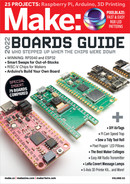
hardware, manufactures products, stuffs boxes,
runs the pick-and-place, manages support,
and occasionally finds time for social media.
His Pixelblaze series of LED controllers have
taken the LED art community by storm, as they
offer easy pattern creation via web browser
with no coding required (learn more about LED
controllers on page 70).
LED BURN AND CAULDRON BUBBLE
Debra Ansell (Figure
B
) used to juggle the many
hats of the entrepreneur as well, but prefers
unbridled creativity to tax law, so has put aside
bookkeeping to give herself fully to whatever
inspiration strikes — frequently wearables,
always LEDs. She describes her brain as a
“chaotic cauldron of ideas” where she focuses on
whichever project she is most passionate about,
and pushes others down until they bubble back
up again (sew her Pixelblaze Pillows on page 48).
GOOD MEETS EVIL
Jason Coon (Figure
C
) is a mild-mannered
professional enterprise software developer by
day. But at night, he assumes his alter-ego as
the mad villain behind Evil Genius Labs. Jason
started making LED art for fun, but soon became
inundated with requests to buy his delightful
objets, leading him to create the brand and
its signature Fibonacci spiral LED matrixes.
As an entrepreneur he describes himself as
somewhere between Ben and Debra — he
doesn’t want to make thousands of something
but definitely more than one.
STRANGE BREW
The ingredients to this mélange may seem
obvious now, but the recipe evolved over time
from the diverse experience of its chefs. For
Debra it was wearables all along — she started
with sewable LEDs, learned about Arduino, and
graduated to a fiber optic dress that garnered a
lot of attention. Over time she became aware of
Jason’s Fibonacci boards and Ben’s Pixelblaze
line, and as both started offering smaller versions
Debra got excited about incorporating them into
wearables.
Meanwhile, Jason and Ben had been
collaborating for some time, Ben assembling
classic Fibonacci256 boards and Jason adopting
Ben’s board to create the Fibonacci256 Pixelblaze
(obviating the need for maintaining his own
firmware). When it came to making a wearable,
Debra was top of mind as co-conspirator and they
kept sending her successively smaller prototypes,
like RGB Matryoshka dolls.
STARTING SMALL
As the prototypes shrank, the challenge became
how to power the device on the go. Despite
advances in battery tech, the mAhs required to
move this many electrons for a sustained period
are still substantial. Debra had already been
playing with a behind-the-neck battery holder,
which shifted the weight burden away from the
device and out of sight behind the wearer. Her
final design appears similar to a typical battery
holder except for one weird trick: the circuit is
completed by attaching a magnet to the negative
terminal, making the necklace itself a conductive
strand that provides power to the device.
CONVIVIAL COLLAB
Other challenges? Debra’s chief complaint was
that Ben and Jason are too nice! They also had
difficulty naming the project — with a Twitter poll
resulting in the predictable “Pixel McPixelface”
— before settling together on the final name: Lux
Lavalier.
Parting thoughts? Ben, like many Make: readers,
started out blinking LEDs on a dev board, and fell
in love with that simple yet delightful aesthetic.
Jason quips that he never moved past that stage,
and Debra gladly proclaims, “Let there be light!”
29
make.co
Ben Hencke, Debra Ansell, Jason Coon
A
C
B
M83_028-29_LEDperfectCircle_F1.indd 29M83_028-29_LEDperfectCircle_F1.indd 29 10/10/22 12:28 PM10/10/22 12:28 PM
..................Content has been hidden....................
You can't read the all page of ebook, please click here login for view all page.
